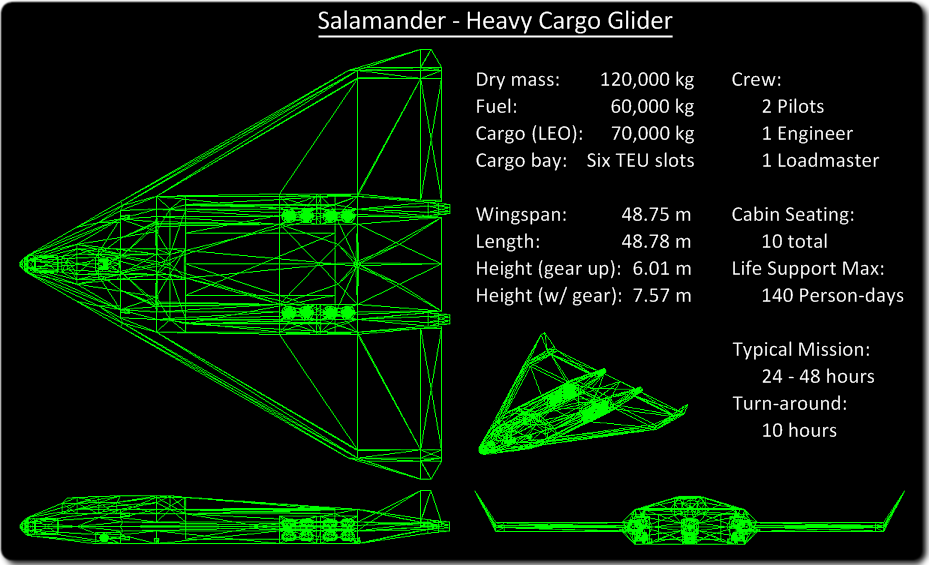Difference between revisions of "Salamander"
m |
|||
| Line 1: | Line 1: | ||
| − | = | + | =Description= |
| + | [[Image:SalamanderPlacard.png|right]] | ||
| − | [[ | + | The Salamander is a near-future realistic heavy-lift glider. It is a part of the [[Manifest Destiny]] universe and serves as the primary method of transportation. The primary mission of the Salamander is launching cargo from Earth to Low Earth Orbit and returning cargo back to Earth. The vessel is well suited to Earth's atmosphere due to the very large wing area and streamlined profile. It has a very low wing loading of 38 lbs/ft^2 (187 kg/m^2), allowing it to glide for an extremely long time with very stable aerodynamic properties. (Compare to the space shuttle's approximately 110 lbs/ft^2.) |
| + | |||
| + | The cargo bay is designed to hold up to six [[TEU]] units. | ||
| + | |||
| + | ==Powerplant== | ||
| + | |||
| + | The Salamander is equipped with an Antimatter Thermal Powerplant, used for both power generation and propulsion. A miniscule amount of antimatter (AM) is stored using magnetic confinement in the engine compartment. For propulsion, every second a few micrograms of antimatter and several kg of liquid reaction mass are injected into the combustion chambers. The typical reaction mass is purified water. An AM reaction immediately increases the temperature and pressure of the reaction mass, causing it to expel out of the nozzles. | ||
| + | |||
| + | Energy production occurs using a similar process at much lower energy levels. | ||
| + | |||
| + | ==History== | ||
| + | |||
| + | A series of events took place leading up to the design and production of the Salamander. See [[Manifest Destiny History]] for details. | ||
| + | |||
| + | In 2021, gasoline prices topped $20 per gallon after the world-wide supply of crude oil and petroleum fell quicker than anyone predicted. Scientist and policy makers from 54 countries, avoiding prohibitively expensive travel as a statement, used the internet to convene the World Energy Panel of 2023. Encouraged bt the recent discovery of antimatter within in Van Allen belts, the panel determined that the use of antimatter as an energy source was humanity's best hope for a global energy solution. Significant applied research grants were made available to the most promising antimatter research laboratories. | ||
| + | |||
| + | [Unfinished, move to history page.] | ||
{| class="wikitable" border="1" cellpadding="2" cellspacing="0" style="width:600px" | {| class="wikitable" border="1" cellpadding="2" cellspacing="0" style="width:600px" | ||
Revision as of 04:31, 1 May 2007
Description
The Salamander is a near-future realistic heavy-lift glider. It is a part of the Manifest Destiny universe and serves as the primary method of transportation. The primary mission of the Salamander is launching cargo from Earth to Low Earth Orbit and returning cargo back to Earth. The vessel is well suited to Earth's atmosphere due to the very large wing area and streamlined profile. It has a very low wing loading of 38 lbs/ft^2 (187 kg/m^2), allowing it to glide for an extremely long time with very stable aerodynamic properties. (Compare to the space shuttle's approximately 110 lbs/ft^2.)
The cargo bay is designed to hold up to six TEU units.
Powerplant
The Salamander is equipped with an Antimatter Thermal Powerplant, used for both power generation and propulsion. A miniscule amount of antimatter (AM) is stored using magnetic confinement in the engine compartment. For propulsion, every second a few micrograms of antimatter and several kg of liquid reaction mass are injected into the combustion chambers. The typical reaction mass is purified water. An AM reaction immediately increases the temperature and pressure of the reaction mass, causing it to expel out of the nozzles.
Energy production occurs using a similar process at much lower energy levels.
History
A series of events took place leading up to the design and production of the Salamander. See Manifest Destiny History for details.
In 2021, gasoline prices topped $20 per gallon after the world-wide supply of crude oil and petroleum fell quicker than anyone predicted. Scientist and policy makers from 54 countries, avoiding prohibitively expensive travel as a statement, used the internet to convene the World Energy Panel of 2023. Encouraged bt the recent discovery of antimatter within in Van Allen belts, the panel determined that the use of antimatter as an energy source was humanity's best hope for a global energy solution. Significant applied research grants were made available to the most promising antimatter research laboratories.
[Unfinished, move to history page.]
| Wingspan: | 48.75 meters |
| Length: | 48.78 m |
| Height (gear up): | 6.01 m |
| Height (gear down): | 7.57 m |
| Minimum Crew: | 2 Pilots, 1 Flight Engineer, 1 Loadmaster |
| Maximum Cabin Seating: | 10 |
| Typical mission length: | 24-48 hours |
| Mission turn-around time | 10 hours |
| Max Life Support (4 crew): | 35 days |
| Max Life Support (10 crew): | 14 days |
| Dry mass: | 120 metric tons |
| Fuel capacity: | 60 metric tons |
| Lifting capacity:
(Earth to LEO): |
70 metric tons |
| Cargo configuration: | Up to 6 TEU units in any combination |
